PROJ6000: PMBOK versus PRINCE2 Methodologies in Project Management
VerifiedAdded on 2023/06/11
|8
|1818
|325
Report
AI Summary
This report provides a detailed comparison of the PMBOK (Project Management Body of Knowledge) and PRINCE2 (Projects IN Controlled Environments) project management methodologies, examining their similarities, differences, strengths, and weaknesses in the context of contemporary project management. It explores how each methodology approaches project risk management, their applicability to different project types, and their lifecycle implications, covering stages from project initiation to closure. The report concludes that both PMBOK and PRINCE2 offer valuable frameworks for managing projects effectively, emphasizing the importance of selecting the appropriate methodology based on project requirements and organizational context. The analysis is supported by references to relevant books and journals in the field of project management.

PMBOK versus PRINCE2 in
contemporary projects
contemporary projects
Paraphrase This Document
Need a fresh take? Get an instant paraphrase of this document with our AI Paraphraser
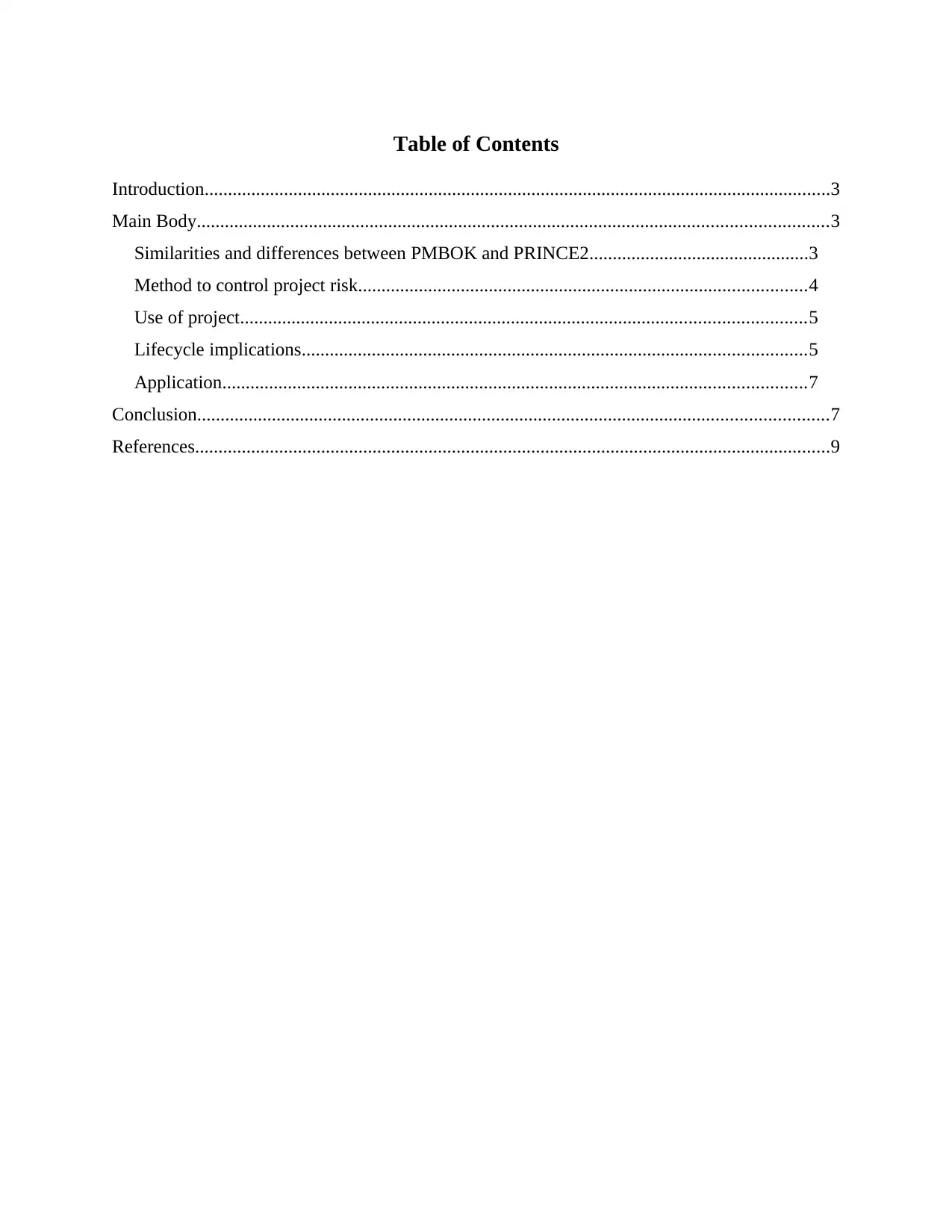
Table of Contents
Introduction......................................................................................................................................3
Main Body.......................................................................................................................................3
Similarities and differences between PMBOK and PRINCE2...............................................3
Method to control project risk................................................................................................4
Use of project.........................................................................................................................5
Lifecycle implications............................................................................................................5
Application.............................................................................................................................7
Conclusion.......................................................................................................................................7
References........................................................................................................................................9
Introduction......................................................................................................................................3
Main Body.......................................................................................................................................3
Similarities and differences between PMBOK and PRINCE2...............................................3
Method to control project risk................................................................................................4
Use of project.........................................................................................................................5
Lifecycle implications............................................................................................................5
Application.............................................................................................................................7
Conclusion.......................................................................................................................................7
References........................................................................................................................................9
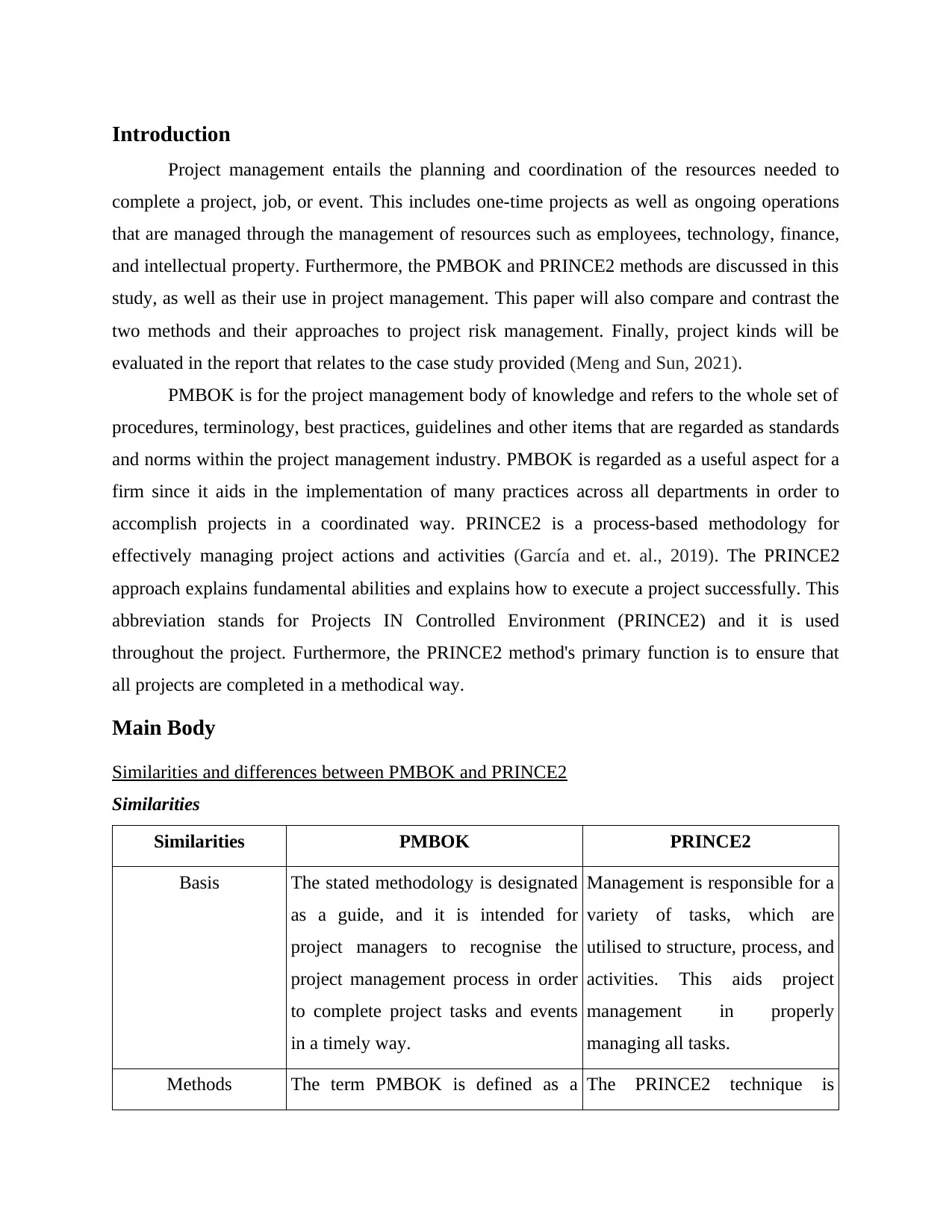
Introduction
Project management entails the planning and coordination of the resources needed to
complete a project, job, or event. This includes one-time projects as well as ongoing operations
that are managed through the management of resources such as employees, technology, finance,
and intellectual property. Furthermore, the PMBOK and PRINCE2 methods are discussed in this
study, as well as their use in project management. This paper will also compare and contrast the
two methods and their approaches to project risk management. Finally, project kinds will be
evaluated in the report that relates to the case study provided (Meng and Sun, 2021).
PMBOK is for the project management body of knowledge and refers to the whole set of
procedures, terminology, best practices, guidelines and other items that are regarded as standards
and norms within the project management industry. PMBOK is regarded as a useful aspect for a
firm since it aids in the implementation of many practices across all departments in order to
accomplish projects in a coordinated way. PRINCE2 is a process-based methodology for
effectively managing project actions and activities (García and et. al., 2019). The PRINCE2
approach explains fundamental abilities and explains how to execute a project successfully. This
abbreviation stands for Projects IN Controlled Environment (PRINCE2) and it is used
throughout the project. Furthermore, the PRINCE2 method's primary function is to ensure that
all projects are completed in a methodical way.
Main Body
Similarities and differences between PMBOK and PRINCE2
Similarities
Similarities PMBOK PRINCE2
Basis The stated methodology is designated
as a guide, and it is intended for
project managers to recognise the
project management process in order
to complete project tasks and events
in a timely way.
Management is responsible for a
variety of tasks, which are
utilised to structure, process, and
activities. This aids project
management in properly
managing all tasks.
Methods The term PMBOK is defined as a The PRINCE2 technique is
Project management entails the planning and coordination of the resources needed to
complete a project, job, or event. This includes one-time projects as well as ongoing operations
that are managed through the management of resources such as employees, technology, finance,
and intellectual property. Furthermore, the PMBOK and PRINCE2 methods are discussed in this
study, as well as their use in project management. This paper will also compare and contrast the
two methods and their approaches to project risk management. Finally, project kinds will be
evaluated in the report that relates to the case study provided (Meng and Sun, 2021).
PMBOK is for the project management body of knowledge and refers to the whole set of
procedures, terminology, best practices, guidelines and other items that are regarded as standards
and norms within the project management industry. PMBOK is regarded as a useful aspect for a
firm since it aids in the implementation of many practices across all departments in order to
accomplish projects in a coordinated way. PRINCE2 is a process-based methodology for
effectively managing project actions and activities (García and et. al., 2019). The PRINCE2
approach explains fundamental abilities and explains how to execute a project successfully. This
abbreviation stands for Projects IN Controlled Environment (PRINCE2) and it is used
throughout the project. Furthermore, the PRINCE2 method's primary function is to ensure that
all projects are completed in a methodical way.
Main Body
Similarities and differences between PMBOK and PRINCE2
Similarities
Similarities PMBOK PRINCE2
Basis The stated methodology is designated
as a guide, and it is intended for
project managers to recognise the
project management process in order
to complete project tasks and events
in a timely way.
Management is responsible for a
variety of tasks, which are
utilised to structure, process, and
activities. This aids project
management in properly
managing all tasks.
Methods The term PMBOK is defined as a The PRINCE2 technique is
⊘ This is a preview!⊘
Do you want full access?
Subscribe today to unlock all pages.

Trusted by 1+ million students worldwide
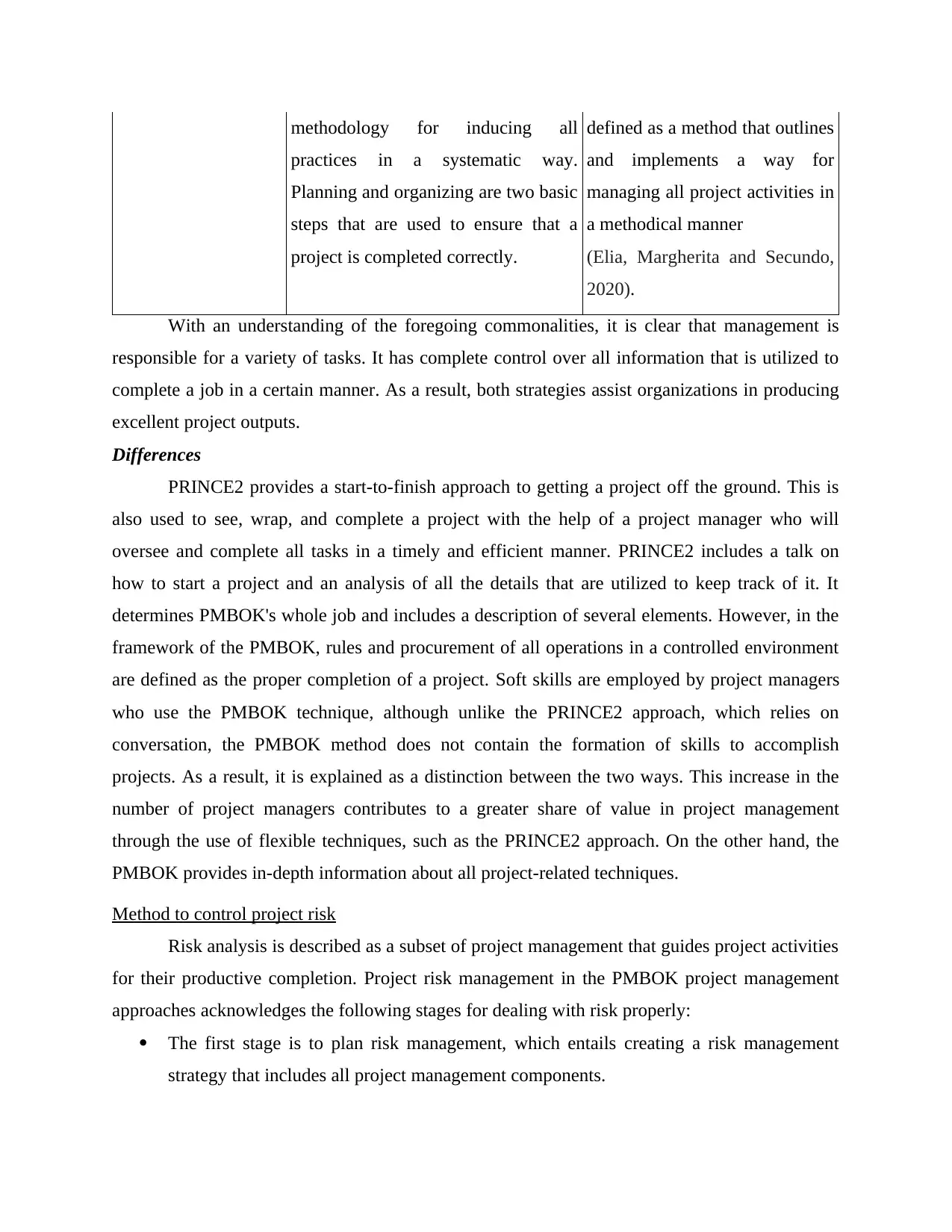
methodology for inducing all
practices in a systematic way.
Planning and organizing are two basic
steps that are used to ensure that a
project is completed correctly.
defined as a method that outlines
and implements a way for
managing all project activities in
a methodical manner
(Elia, Margherita and Secundo,
2020).
With an understanding of the foregoing commonalities, it is clear that management is
responsible for a variety of tasks. It has complete control over all information that is utilized to
complete a job in a certain manner. As a result, both strategies assist organizations in producing
excellent project outputs.
Differences
PRINCE2 provides a start-to-finish approach to getting a project off the ground. This is
also used to see, wrap, and complete a project with the help of a project manager who will
oversee and complete all tasks in a timely and efficient manner. PRINCE2 includes a talk on
how to start a project and an analysis of all the details that are utilized to keep track of it. It
determines PMBOK's whole job and includes a description of several elements. However, in the
framework of the PMBOK, rules and procurement of all operations in a controlled environment
are defined as the proper completion of a project. Soft skills are employed by project managers
who use the PMBOK technique, although unlike the PRINCE2 approach, which relies on
conversation, the PMBOK method does not contain the formation of skills to accomplish
projects. As a result, it is explained as a distinction between the two ways. This increase in the
number of project managers contributes to a greater share of value in project management
through the use of flexible techniques, such as the PRINCE2 approach. On the other hand, the
PMBOK provides in-depth information about all project-related techniques.
Method to control project risk
Risk analysis is described as a subset of project management that guides project activities
for their productive completion. Project risk management in the PMBOK project management
approaches acknowledges the following stages for dealing with risk properly:
The first stage is to plan risk management, which entails creating a risk management
strategy that includes all project management components.
practices in a systematic way.
Planning and organizing are two basic
steps that are used to ensure that a
project is completed correctly.
defined as a method that outlines
and implements a way for
managing all project activities in
a methodical manner
(Elia, Margherita and Secundo,
2020).
With an understanding of the foregoing commonalities, it is clear that management is
responsible for a variety of tasks. It has complete control over all information that is utilized to
complete a job in a certain manner. As a result, both strategies assist organizations in producing
excellent project outputs.
Differences
PRINCE2 provides a start-to-finish approach to getting a project off the ground. This is
also used to see, wrap, and complete a project with the help of a project manager who will
oversee and complete all tasks in a timely and efficient manner. PRINCE2 includes a talk on
how to start a project and an analysis of all the details that are utilized to keep track of it. It
determines PMBOK's whole job and includes a description of several elements. However, in the
framework of the PMBOK, rules and procurement of all operations in a controlled environment
are defined as the proper completion of a project. Soft skills are employed by project managers
who use the PMBOK technique, although unlike the PRINCE2 approach, which relies on
conversation, the PMBOK method does not contain the formation of skills to accomplish
projects. As a result, it is explained as a distinction between the two ways. This increase in the
number of project managers contributes to a greater share of value in project management
through the use of flexible techniques, such as the PRINCE2 approach. On the other hand, the
PMBOK provides in-depth information about all project-related techniques.
Method to control project risk
Risk analysis is described as a subset of project management that guides project activities
for their productive completion. Project risk management in the PMBOK project management
approaches acknowledges the following stages for dealing with risk properly:
The first stage is to plan risk management, which entails creating a risk management
strategy that includes all project management components.
Paraphrase This Document
Need a fresh take? Get an instant paraphrase of this document with our AI Paraphraser
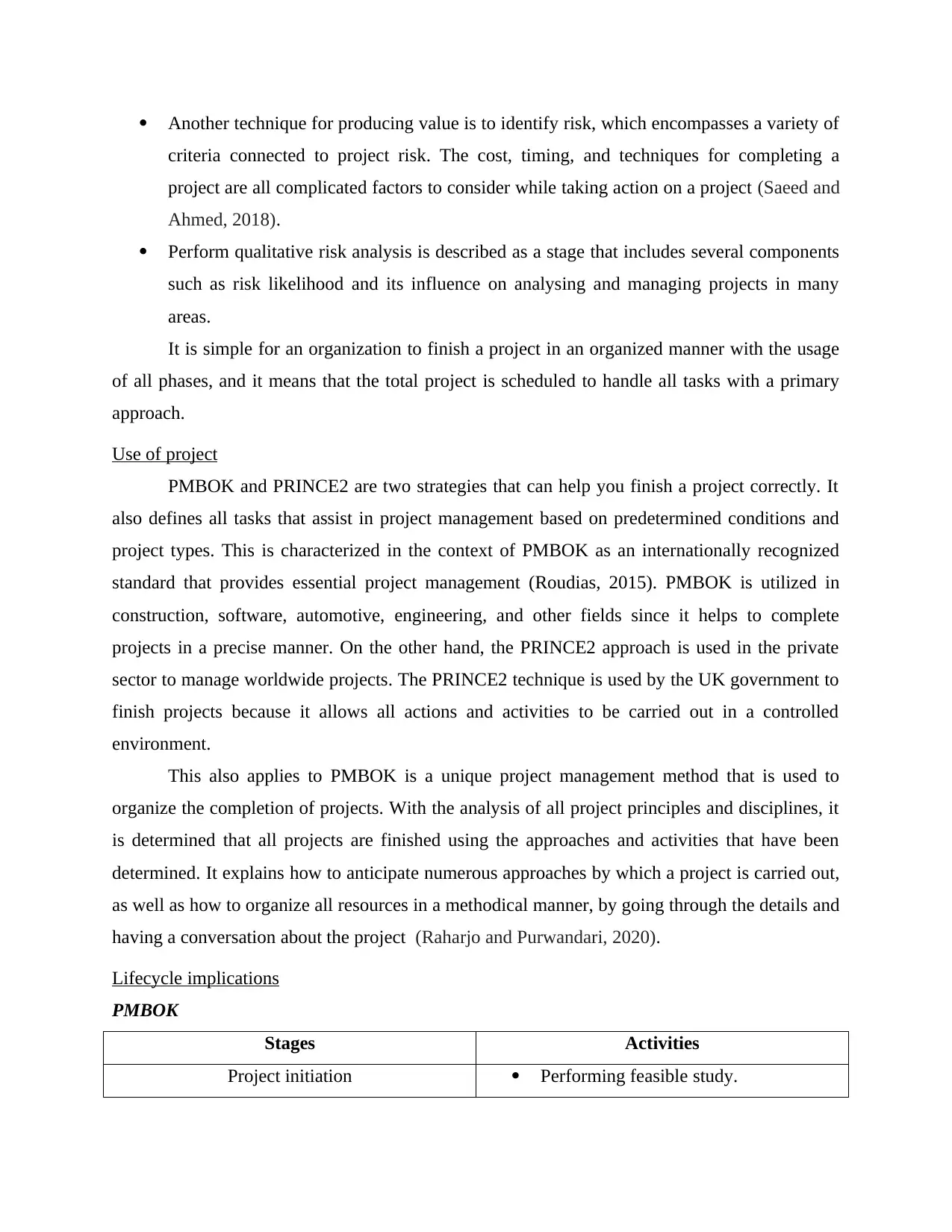
Another technique for producing value is to identify risk, which encompasses a variety of
criteria connected to project risk. The cost, timing, and techniques for completing a
project are all complicated factors to consider while taking action on a project (Saeed and
Ahmed, 2018).
Perform qualitative risk analysis is described as a stage that includes several components
such as risk likelihood and its influence on analysing and managing projects in many
areas.
It is simple for an organization to finish a project in an organized manner with the usage
of all phases, and it means that the total project is scheduled to handle all tasks with a primary
approach.
Use of project
PMBOK and PRINCE2 are two strategies that can help you finish a project correctly. It
also defines all tasks that assist in project management based on predetermined conditions and
project types. This is characterized in the context of PMBOK as an internationally recognized
standard that provides essential project management (Roudias, 2015). PMBOK is utilized in
construction, software, automotive, engineering, and other fields since it helps to complete
projects in a precise manner. On the other hand, the PRINCE2 approach is used in the private
sector to manage worldwide projects. The PRINCE2 technique is used by the UK government to
finish projects because it allows all actions and activities to be carried out in a controlled
environment.
This also applies to PMBOK is a unique project management method that is used to
organize the completion of projects. With the analysis of all project principles and disciplines, it
is determined that all projects are finished using the approaches and activities that have been
determined. It explains how to anticipate numerous approaches by which a project is carried out,
as well as how to organize all resources in a methodical manner, by going through the details and
having a conversation about the project (Raharjo and Purwandari, 2020).
Lifecycle implications
PMBOK
Stages Activities
Project initiation Performing feasible study.
criteria connected to project risk. The cost, timing, and techniques for completing a
project are all complicated factors to consider while taking action on a project (Saeed and
Ahmed, 2018).
Perform qualitative risk analysis is described as a stage that includes several components
such as risk likelihood and its influence on analysing and managing projects in many
areas.
It is simple for an organization to finish a project in an organized manner with the usage
of all phases, and it means that the total project is scheduled to handle all tasks with a primary
approach.
Use of project
PMBOK and PRINCE2 are two strategies that can help you finish a project correctly. It
also defines all tasks that assist in project management based on predetermined conditions and
project types. This is characterized in the context of PMBOK as an internationally recognized
standard that provides essential project management (Roudias, 2015). PMBOK is utilized in
construction, software, automotive, engineering, and other fields since it helps to complete
projects in a precise manner. On the other hand, the PRINCE2 approach is used in the private
sector to manage worldwide projects. The PRINCE2 technique is used by the UK government to
finish projects because it allows all actions and activities to be carried out in a controlled
environment.
This also applies to PMBOK is a unique project management method that is used to
organize the completion of projects. With the analysis of all project principles and disciplines, it
is determined that all projects are finished using the approaches and activities that have been
determined. It explains how to anticipate numerous approaches by which a project is carried out,
as well as how to organize all resources in a methodical manner, by going through the details and
having a conversation about the project (Raharjo and Purwandari, 2020).
Lifecycle implications
PMBOK
Stages Activities
Project initiation Performing feasible study.
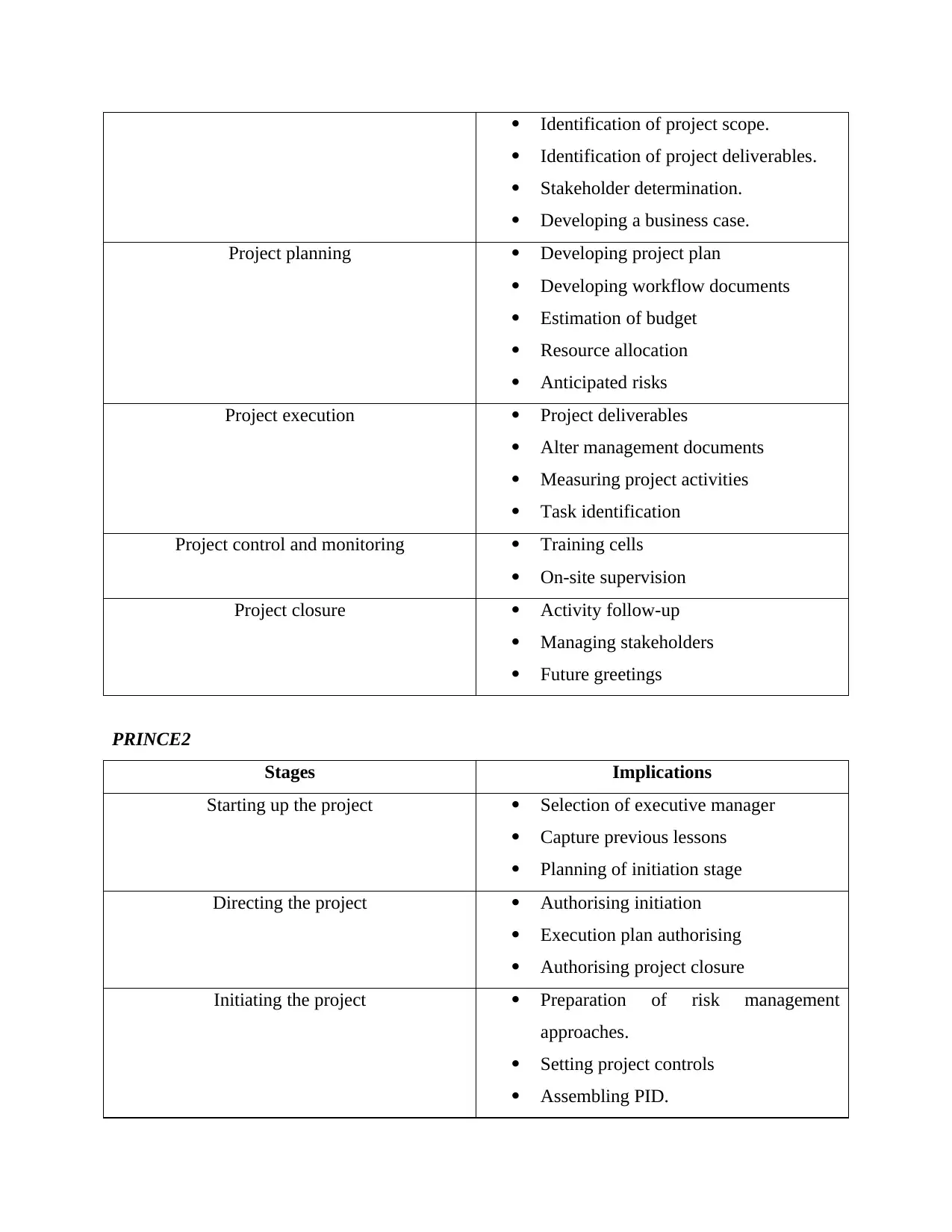
Identification of project scope.
Identification of project deliverables.
Stakeholder determination.
Developing a business case.
Project planning Developing project plan
Developing workflow documents
Estimation of budget
Resource allocation
Anticipated risks
Project execution Project deliverables
Alter management documents
Measuring project activities
Task identification
Project control and monitoring Training cells
On-site supervision
Project closure Activity follow-up
Managing stakeholders
Future greetings
PRINCE2
Stages Implications
Starting up the project Selection of executive manager
Capture previous lessons
Planning of initiation stage
Directing the project Authorising initiation
Execution plan authorising
Authorising project closure
Initiating the project Preparation of risk management
approaches.
Setting project controls
Assembling PID.
Identification of project deliverables.
Stakeholder determination.
Developing a business case.
Project planning Developing project plan
Developing workflow documents
Estimation of budget
Resource allocation
Anticipated risks
Project execution Project deliverables
Alter management documents
Measuring project activities
Task identification
Project control and monitoring Training cells
On-site supervision
Project closure Activity follow-up
Managing stakeholders
Future greetings
PRINCE2
Stages Implications
Starting up the project Selection of executive manager
Capture previous lessons
Planning of initiation stage
Directing the project Authorising initiation
Execution plan authorising
Authorising project closure
Initiating the project Preparation of risk management
approaches.
Setting project controls
Assembling PID.
⊘ This is a preview!⊘
Do you want full access?
Subscribe today to unlock all pages.

Trusted by 1+ million students worldwide
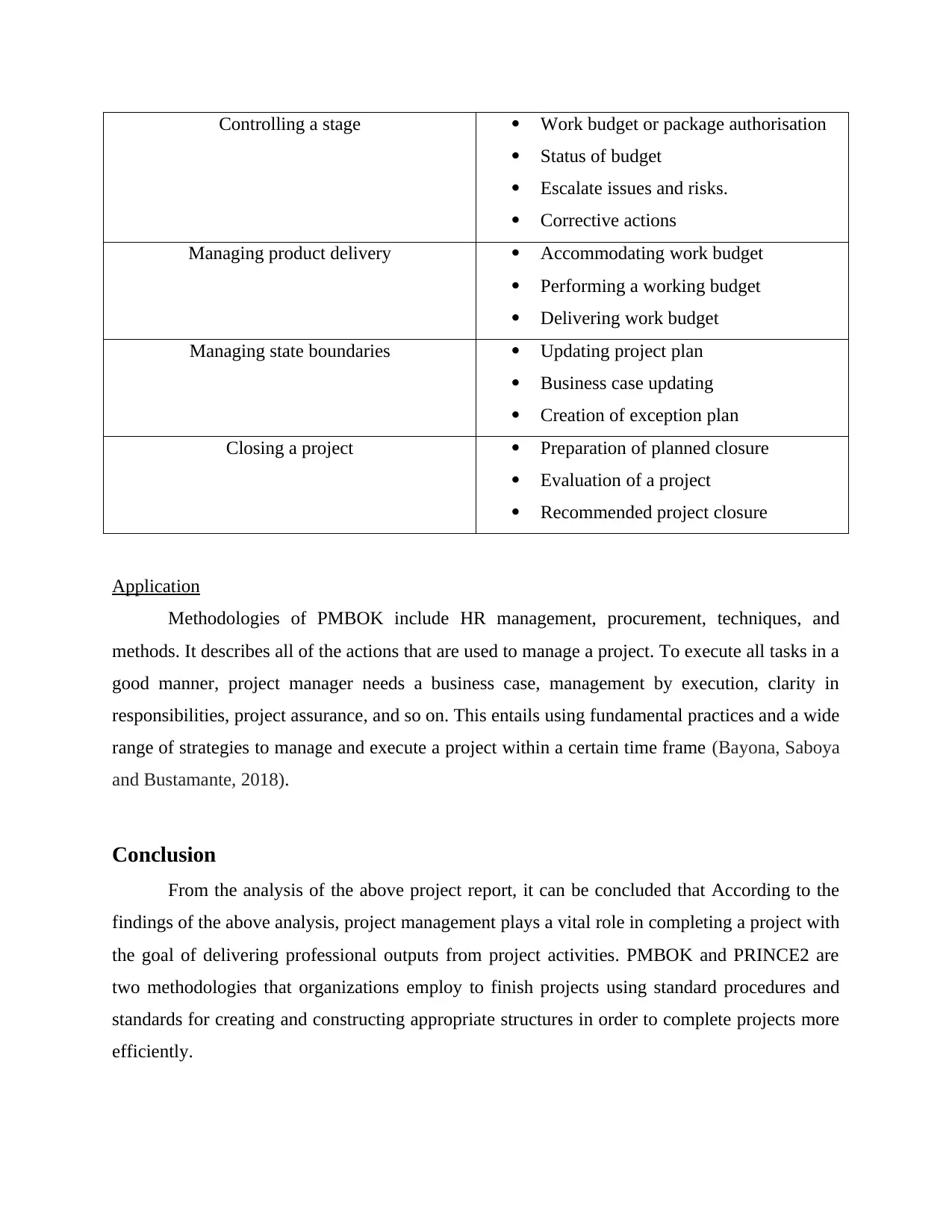
Controlling a stage Work budget or package authorisation
Status of budget
Escalate issues and risks.
Corrective actions
Managing product delivery Accommodating work budget
Performing a working budget
Delivering work budget
Managing state boundaries Updating project plan
Business case updating
Creation of exception plan
Closing a project Preparation of planned closure
Evaluation of a project
Recommended project closure
Application
Methodologies of PMBOK include HR management, procurement, techniques, and
methods. It describes all of the actions that are used to manage a project. To execute all tasks in a
good manner, project manager needs a business case, management by execution, clarity in
responsibilities, project assurance, and so on. This entails using fundamental practices and a wide
range of strategies to manage and execute a project within a certain time frame (Bayona, Saboya
and Bustamante, 2018).
Conclusion
From the analysis of the above project report, it can be concluded that According to the
findings of the above analysis, project management plays a vital role in completing a project with
the goal of delivering professional outputs from project activities. PMBOK and PRINCE2 are
two methodologies that organizations employ to finish projects using standard procedures and
standards for creating and constructing appropriate structures in order to complete projects more
efficiently.
Status of budget
Escalate issues and risks.
Corrective actions
Managing product delivery Accommodating work budget
Performing a working budget
Delivering work budget
Managing state boundaries Updating project plan
Business case updating
Creation of exception plan
Closing a project Preparation of planned closure
Evaluation of a project
Recommended project closure
Application
Methodologies of PMBOK include HR management, procurement, techniques, and
methods. It describes all of the actions that are used to manage a project. To execute all tasks in a
good manner, project manager needs a business case, management by execution, clarity in
responsibilities, project assurance, and so on. This entails using fundamental practices and a wide
range of strategies to manage and execute a project within a certain time frame (Bayona, Saboya
and Bustamante, 2018).
Conclusion
From the analysis of the above project report, it can be concluded that According to the
findings of the above analysis, project management plays a vital role in completing a project with
the goal of delivering professional outputs from project activities. PMBOK and PRINCE2 are
two methodologies that organizations employ to finish projects using standard procedures and
standards for creating and constructing appropriate structures in order to complete projects more
efficiently.
Paraphrase This Document
Need a fresh take? Get an instant paraphrase of this document with our AI Paraphraser
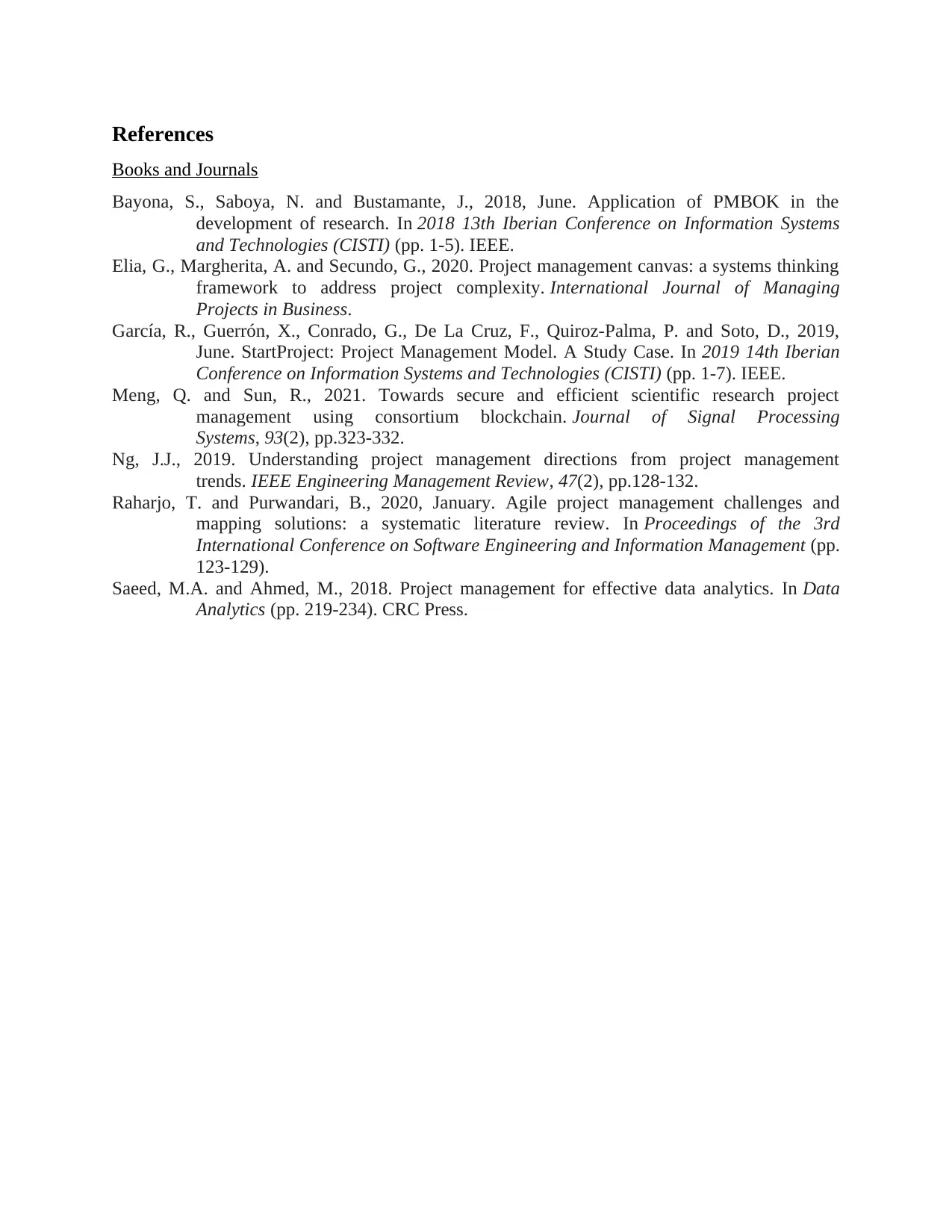
References
Books and Journals
Bayona, S., Saboya, N. and Bustamante, J., 2018, June. Application of PMBOK in the
development of research. In 2018 13th Iberian Conference on Information Systems
and Technologies (CISTI) (pp. 1-5). IEEE.
Elia, G., Margherita, A. and Secundo, G., 2020. Project management canvas: a systems thinking
framework to address project complexity. International Journal of Managing
Projects in Business.
García, R., Guerrón, X., Conrado, G., De La Cruz, F., Quiroz-Palma, P. and Soto, D., 2019,
June. StartProject: Project Management Model. A Study Case. In 2019 14th Iberian
Conference on Information Systems and Technologies (CISTI) (pp. 1-7). IEEE.
Meng, Q. and Sun, R., 2021. Towards secure and efficient scientific research project
management using consortium blockchain. Journal of Signal Processing
Systems, 93(2), pp.323-332.
Ng, J.J., 2019. Understanding project management directions from project management
trends. IEEE Engineering Management Review, 47(2), pp.128-132.
Raharjo, T. and Purwandari, B., 2020, January. Agile project management challenges and
mapping solutions: a systematic literature review. In Proceedings of the 3rd
International Conference on Software Engineering and Information Management (pp.
123-129).
Saeed, M.A. and Ahmed, M., 2018. Project management for effective data analytics. In Data
Analytics (pp. 219-234). CRC Press.
Books and Journals
Bayona, S., Saboya, N. and Bustamante, J., 2018, June. Application of PMBOK in the
development of research. In 2018 13th Iberian Conference on Information Systems
and Technologies (CISTI) (pp. 1-5). IEEE.
Elia, G., Margherita, A. and Secundo, G., 2020. Project management canvas: a systems thinking
framework to address project complexity. International Journal of Managing
Projects in Business.
García, R., Guerrón, X., Conrado, G., De La Cruz, F., Quiroz-Palma, P. and Soto, D., 2019,
June. StartProject: Project Management Model. A Study Case. In 2019 14th Iberian
Conference on Information Systems and Technologies (CISTI) (pp. 1-7). IEEE.
Meng, Q. and Sun, R., 2021. Towards secure and efficient scientific research project
management using consortium blockchain. Journal of Signal Processing
Systems, 93(2), pp.323-332.
Ng, J.J., 2019. Understanding project management directions from project management
trends. IEEE Engineering Management Review, 47(2), pp.128-132.
Raharjo, T. and Purwandari, B., 2020, January. Agile project management challenges and
mapping solutions: a systematic literature review. In Proceedings of the 3rd
International Conference on Software Engineering and Information Management (pp.
123-129).
Saeed, M.A. and Ahmed, M., 2018. Project management for effective data analytics. In Data
Analytics (pp. 219-234). CRC Press.
1 out of 8
Related Documents
Your All-in-One AI-Powered Toolkit for Academic Success.
+13062052269
info@desklib.com
Available 24*7 on WhatsApp / Email
![[object Object]](/_next/static/media/star-bottom.7253800d.svg)
Unlock your academic potential
Copyright © 2020–2025 A2Z Services. All Rights Reserved. Developed and managed by ZUCOL.





